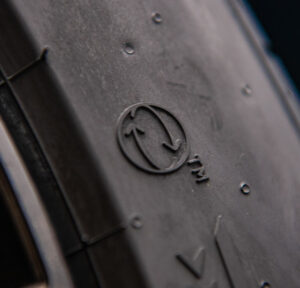New Pirelli logo identifies tires with at least 50 percent sustainable materials
Milan, Italy – Pirelli has created a bespoke logo to identify tires that contain at least 50% materials of bio-based and recycled origin. The new marking – which depicts two arrows in a circle and will be adopted on new products – underlines Pirelli’s commitment to the environment, maintaining the high level of safety performance inherent in every single tire produced by the Italian firm. This new logo is also designed as a clear indication for customers, allowing them to choose more sustainable tires.
The latest Pirelli marking was used for the first time on the P Zero E. This tire contains more than 55% of materials of bio-based and recycled origin* throughout the entire range at launch, as certified by Bureau Veritas: a world leader in verifying conformity and certification in quality, environment, health, safety, and social responsibility standards (ISO14021). Third-party verification of eco-compatible materials will continue to be standard across all future products that adopt the new logo.
Giovanni Tronchetti Provera, Head of Sustainability and Future Mobility at Pirelli, said: “For several years, Pirelli has consistently reduced its environmental impact: a policy confirmed by all the main sustainability indices, which have recognized our commitment and transparency both in terms of results and ethos. For this reason, for example, we indicate the percentage of sustainable materials by saying ‘at least’ rather than ‘up to’. We will now continue down this road, which our car manufacturer partners also recognize and appreciate.”
Pirelli’s path towards reduced environmental impact includes the ever-increasing use of sustainable materials. Pirelli’s initial objective, originally set for 2025, has already been achieved two years early thanks to P Zero E. The next step, set for selected product lines by 2030, envisages the use of at least 60% of materials of bio-based origin and 12% recycled, with less than 30% of fossil-derived ingredients. Pirelli aims to regularly improve these targets thanks to the technological innovation of all the different departments involved in tire development.
These innovations have set in motion a virtuous path both at quantitative level – thanks to increasingly higher percentages of sustainable materials – and qualitative level, through the certification of supply chains to internationally accredited standards.
In 2021, for example, Pirelli was first to produce an FSC® (Forest Stewardship Council®) certified tyre that uses natural rubber and FSC® rayon. As a result, customers had the guarantee that all materials sourced from forests came from plantations that promote biological diversity, while bringing economic sustainability to the lives of local communities and workers.
The main challenge in developing the new P Zero E was to combine the need for sustainability with the high performance required from a UHP tire. This objective was reached thanks to these new materials, which include:
Lignin comes from the scrap of the pulp and paper industry. Lignin contributes to tire durability and foreseen rolling resistance reduction.
Rice husk ash silica derives from the scrap of rice cultivation. Silica is widely used in tread compounds to obtain a high level of performance in wet conditions. Rice husk ash silica is a good replacement for fossil-based silica in such tread applications.
Circular carbon black derives from end-of-life tires pyrolysis oil. Pyrolysis is a way to prevent landfill disposal of end-of-life tires. Carbon black is used in rubber compounds to optimize stability, strength, and durability of tires.
Bio-circular polymers are made from monomers derived from used cooking oils or tire pyrolysis oil. They are a replacement for fossil-sourced polymers.
Natural rubber is obtained from the latex of Hevea Brasiliensis, the rubber tree. This is a material 100% derived from biomass.
Bio resins are plasticizers deriving from vegetal biomass such as plant seeds (sunflower or canola) or forest-based resins. Bio resins are versatile ingredients, providing a better balance of dry and wet performance.
Rayon is a textile reinforcement of a tire, with fibers deriving from cellulose.

